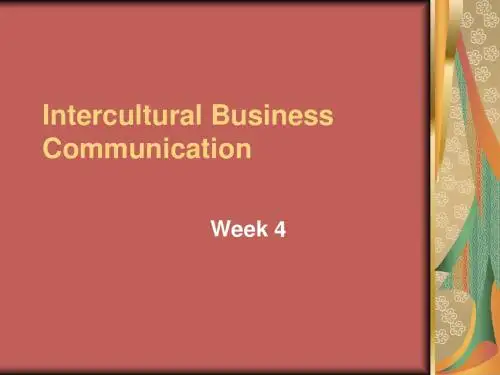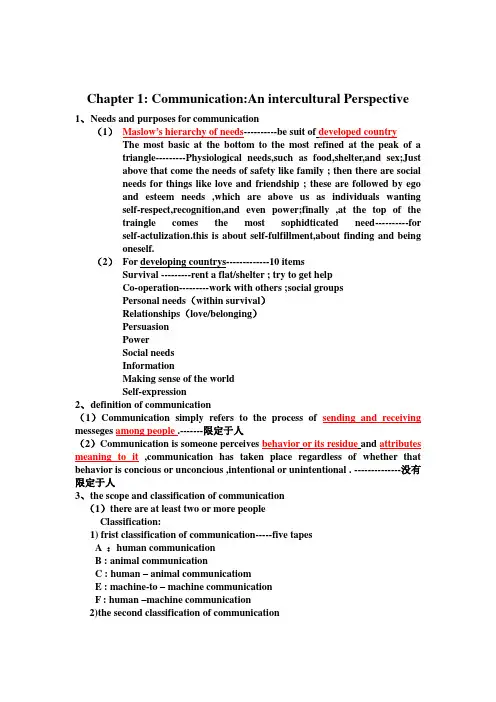【资料】跨文化商务交际-4汇编
- 格式:ppt
- 大小:1.54 MB
- 文档页数:37


跨文化交流与国际商务的培训资料在当今全球化的时代,跨文化交流和国际商务的重要性不言而喻。
对于企业和个人来说,了解、掌握跨文化交流和国际商务的技巧和知识,将能够提升他们在全球市场的竞争力。
本文将为您提供一些关于跨文化交流与国际商务的培训资料。
一、跨文化交流培训1. 了解不同文化背景跨文化交流的关键在于了解不同国家和民族的文化背景。
因此,在培训中应该包括对各个国家的历史、宗教、价值观、思维方式、社会习俗等方面的介绍。
只有了解了特定文化的背景,才能更好地融入和适应。
2. 学习跨文化交流技巧跨文化交流涉及到语言、非语言沟通和行为准则等方面的技巧。
培训资料应该包括这些技巧的具体教授,例如如何避免语言障碍、如何解读不同文化的非语言信号、如何礼貌地表达意见等等。
这些技巧将帮助个人更好地与来自不同文化背景的人进行有效的沟通。
3. 探索文化差异的影响在跨文化交流中,文化差异常常会导致误解和冲突。
培训资料应该帮助个人意识到这些文化差异并了解其潜在影响。
通过了解不同文化的沟通风格、决策方式、时间观念等,个人将能够更好地调整自己的行为与他人协调。
二、国际商务培训1. 全球市场的了解国际商务培训的首要目标是帮助个人了解全球市场的现状和趋势。
培训资料应涵盖全球经济的概述、主要国家和地区的经济特点等。
了解全球市场将有助于个人做出明智的决策和规划。
2. 跨国公司运营管理跨国公司的运营管理与国内企业存在诸多不同之处。
培训资料应该关注跨国公司运营管理的特点和挑战,例如如何处理不同法律环境、如何应对文化差异、如何协调不同国家之间的业务等。
3. 国际商务谈判技巧谈判是国际商务中的常见活动,而在跨文化的环境中,谈判技巧变得尤为重要。
培训资料应该包括国际商务谈判的基本原则和技巧,例如如何处理文化差异、如何建立信任、如何达成双赢等。
4. 跨国合作伙伴关系管理在国际商务中,与跨国合作伙伴的关系对业务发展至关重要。
培训资料应该着重介绍与跨国合作伙伴的合作模式、合作方法以及如何建立和维护良好的合作关系。


跨文化商务交际Intercultural Business Communication窦卫霖编著前言一个企业的成功,不仅取决于它的生产能力,而且取决于它的文化能力;在国际商务活动中,还取决于它的跨文化交际能力。
经济全球化的趋势、国际商务活动的日益频繁,越来越显示出对多元文化理解的必要性和跨文化交际能力的重要性。
跨文化意识意味着直接的经济效益。
如果一个企业想让自己的产品在国际市场上占有一席之地,一个跨国公司想在其他国家或地区取得经济效益,那么就不仅需要具有高超的经济、技术和管理水平,而且需要深刻了解对象国的文化。
正因为如此,世界上许多大公司在国际商务活动中都十分重视跨文化交流的研究和培训,许多经贸类大学都把跨文化商务交际课程作为必修课。
21世纪的中国是走向国际广泛合作的中国。
自中国加入WTO以来,国际著名跨国集团公司、金融机构、工商企业都纷纷来中国设立分支机构、分公司,招聘大量的中国雇员。
同时,中国工商贸易企业也在不断加大出口力度,在国内外建立跨国公司,雇佣来自不同文化背景的雇员。
文化合作已成为当代中国商务合作的重要内容。
文化交融现象激励商务英语教学加速培养复合型的经贸外语人才,促进他们不仅要掌握跨学科的专业知识,而且要具备跨文化交往的技能。
在商务英语教学中把跨文化交际能力的培养放在十分突出的位置已经成为普遍的共识。
那么在培养复合型人才的战略中,如何培养和提高跨文化交际的能力呢?在我国,经贸学校一般都开设有关跨文化交际的课程,跨文化交际专著、论文也不断涌现。
但总体来说,跨文化商务交际在我国商界和相关专业的教学中还处于比较薄弱的初级阶段,与发达国家相比还有较大的差距,尤其是如何把商务活动实践与跨文化交际理论结合起来,如何把国际商务文化与中国本土文化结合起来,还是一个难题。
这方面的书籍也特别少,适合商英类专业学生使用的教材更少。
有鉴于此,作者根据多年跨文化交际和跨文化商务交际教学的经验,参考了大量国内外的最新相关材料,编写了这本《跨文化商务交流》教材,希望成为大学英语相关专业学生以及商务人员进修提高的可用教材。




Chapter 1: Communication:An intercultural Perspective 1、N eeds and purposes for communication(1)Maslow’s hierarchy of needs----------be suit of developed country The most basic at the bottom to the most refined at the peak of atriangle---------Physiological needs,such as food,shelter,and sex;Justabove that come the needs of safety like family ; then there are socialneeds for things like love and friendship ; these are followed by egoand esteem needs ,which are above us as individuals wantingself-respect,recognition,and even power;finally ,at the top of thetraingle comes the most sophidticated need----------forself-actulization.this is about self-fulfillment,about finding and beingoneself.(2)For developing countrys-------------10 itemsSurvival ---------rent a flat/shelter ; try to get helpCo-operation---------work with others ;social groupsPersonal needs(within survival)Relationships(love/belonging)PersuasionPowerSocial needsInformationMaking sense of the worldSelf-expression2、d efinition of communication(1)Communication simply refers to the process of sending and receiving messeges among people .-------限定于人(2)Communication is someone perceives behavior or its residue and attributes meaning to it,communication has taken place regardless of whether that behavior is concious or unconcious ,intentional or unintentional . --------------没有限定于人3、the scope and classification of communication(1)there are at least two or more peopleClassification:1) frist classification of communication-----five tapesA :human communicationB : animal communicationC : human – animal communicatiomE : machine-to – machine communicationF : human –machine communication2)the second classification of communication(2)There must be some contact between communicators.(3)There must to be a language shared by communicators.(4)An exchange of information has taken placeThere is often taken as a successful condition of communication .but there are various degrees of success in communication,ranging from complete success,partial success to failure.4、T he process of communicationa)components of communicationThe definition identifies eight key components of communicationwithin the framework of intentional communication:message, ,sender , receiver ,channel , noise , feedback,encoding and decoding.i.messege--------verbal and nonverbal--------carries ideas from oneperson to another.2)sender refers to the person who sends the message .While the receiveris the one who receiver the message. :in order to reduce the uncertaintyor misunderstandings,the sender should think from the receiver’s piontof view when composing the message ,Besides ,the role of sender andreceiver is always changing.3)Channel/Medium refers to the way for sending or receiving message.4)Niose refers to the disturbances along the communicationprocesses ,which may resultunintended message perceived by therecevier .such as environment5)Feedback refers to the reaction from the message receiver to themessage sender.6)Encoding refers to the reaction from the message into asignal;Decoding refers to the process of the receiver interpreting thesignal from the senger.Encoding:the process of collecting message,considered of socialhabits,culture,communications rule.Decoding :the process of collecting feedback.b) Models of communication1. The Linear Model (线性模型)What it basically says is 5Ws:Who A senderSay what Directs a MessageIn which channel Through some MediumTo whom To a receiverAnd with what effect With some effectWhat sender through what message through what channel to whatreceiver with what effectThe theory’s advantages and disadvantagesAdvantages:this is a vary popular model which has been usedby a lot of communication scholars(this is the earlest andstill most useful method);Disadvantage:①human communication involves many morethings. e.g:power relations,rolerelations.age and sex difference,feelings②there are no feesback in this model(itdon’t pay attention to the feedback.).2.The Circular Model(环形模型)The communication is two-way process and thar everyone is both a decoder and an encoder.This model focus on feedback.3)The Contextualized ModelContext refers to the idea that every act of communication must been happen in some sort of surroundings,and what it meant by this is actually quite complicated。



跨文化商务沟通整理跨文化商务沟通是指在国际商务中,不同文化背景之间进行有效沟通和交流的能力。
由于全球化的进程加快,不同国家和地区之间的商务交流日益频繁,跨文化商务沟通能力已成为当代商务人士必备的技能之一、在进行跨文化商务沟通时,需要注意以下几个方面:1.学习目标国家的文化特点。
不同国家和地区有不同的文化特点,包括语言、礼仪、价值观等方面。
在进行跨文化商务沟通前,了解目标国家的文化特点是非常重要的,可以避免因为文化差异而造成的误解和冲突。
2.语言表达的准确性和简洁性。
跨文化商务沟通中语言的准确性和简洁性至关重要。
由于语言的语法和习惯用法差异,对于非母语的商务人士来说,可能会出现理解偏差。
因此,在进行商务沟通时,要用简洁明了的语言表达自己的意思,并且尽量避免使用俚语和隐喻。
3.尊重对方的文化差异。
在与其他国家和地区的商务人士交流时,要尊重对方的文化差异,并且不要将自己的文化标准强加给对方。
要理解并接受对方的文化习惯和价值观,避免因为文化碰撞而导致的误解和冲突。
4.了解目标国家的商务礼仪。
不同国家和地区的商务礼仪有差异。
在进行商务交流时,要遵循目标国家的商务礼仪,包括礼貌用语、礼仪习惯等方面。
这样可以给对方留下良好的印象,并且建立良好的商业关系。
5.有效使用非语言交流方式。
除了语言之外,非语言交流方式也是跨文化商务沟通中的重要因素。
例如,姿势、眼神、微笑等非语言表达方式可以传递出商务人士的诚意和友好,有助于建立信任和合作关系。
6.善于倾听和沟通。
在进行跨文化商务沟通时,要善于倾听对方的意见和建议,并且积极参与到对话中去。
通过有效的沟通,可以更好地了解对方的需求和期望,进而实现双方的合作和共赢。
7.避免使用刻板印象和歧视性语言。
在跨文化商务沟通中,要避免使用刻板印象和歧视性语言。
不同国家和地区的文化是多样的,不能因为个别经历或者偏见而对整个国家或地区的人进行评判。
要用平等和尊重的态度对待对方,保持开放的心态,才能建立良好的商业关系。
Chapter4 Perceiving Nonverbal CommunicationI. The Basics of Nonverbal Communication1. Defining nonverbal communicationDefinition of nonverbal communication:"Communication without the use of words."2. Comparing verbal and nonverbal communicationImportant differences between verbal and nonverbal communication:•Verbal:structured, linguistic and clear•Nonverbal:unstructured, nonlinguistic and ambiguous.•Verbal: conscious, discontinuous, acquired and controllable•Non-verbal: subconscious, continuous, natural and uncontrollableII. Cultural Impact on Nonverbal CommunicationClassifications of nonverbal behaviors:1. Body Movement•posture (姿势)—— standing, sitting, squatting,etc. P.130•gesture (手势,举止)——V, illustrators, regulators, affect display (hand gestures p.132-133)•facial expressions ——smiling and laughing, showing anger (frowning, shouting, gesturing)2. Eye Contact (Table 4-1. p.138)3. Touch —— touch culture and non-touch culture•When used properly, touch can create feelings of warmth and trust; when usedimproperly, touch can betray trust and cause annoyance.•Touch interpreted as power in many cultures: more powerful people touch less powerful people.1) hand-shaking (differs in intensity and duration)2) Hugging and kissing (for old friends, but inappropriate in business situations)4. SmellA number of elements affect the meaning we give to a smell, culture influences our reaction to each of these variables:5. Paralanguage (副语言)It involves sounds but not words, lying between verbal and nonverbal communication. It is divided into 3 categories:•V ocal qualifiers (语音修饰特征)•V ocalization (元音化/浊音化)•SilenceVocal qualifiers (语音修饰特征)—— volume, pitch, rhythm, tempo, resonance, toneVocalization (元音化/浊音化)•Non-word noises "un-huh, oooh, mmmh, etc."•Language fillers "okay, you know".•"Oops" —used to show recognition of a mistake or minor accident, often as part of an apology."Oops! I'm sorry. I just made you miss your bus!"•Used as connectors of ideas, to indicate that sb. is ready to speak or that more time is needed to think things over.Silence•In low-context cultures, people usually view silence as communication gone wrong and generally are uncomfortable with silence•In high-context cultures, people consider silence an integral part of business and social discourse, rather than a failure of communication6. Spatial languagePersonal space•People from high-context cultures were observed standing closer when talking to someone. Low-context cultures appeared to dictate a greater amount of interpersonal space.Office spacePublic space7. Temporal language —— refers to the way in which time is used in a culture. Four basic personality types, each of which experiences time in a unique way that affects their communication with others:•The thinking types: planning, logically plotting issues out through time•The feeling types: viewing the present through past experiences•The sensation types: perceiving time mainly in terms of the present, more action-oriented•The intuitive types: viewing time primarily in terms of the futureMonochronic and polychronic time•M-time cultures: emphasize schedules, a precise reckoning of time, and promptness; rude to do two things at once (Europe)•P-time cultures: emphasize the completion of transactions and the involvement of people rather than a rigid adherence to the clock (Latin America and the Middle East)Monochronic and Polychronic Time SystemsPunctuality and promptness (M-time)•When doing business in countries that adhere to M-time schedules, it is important to be on time for meetings, whish typically end at the appointed time so that participants can be on time for their next meeting.•When doing business in countries that adhere to P-time schedules, it is common to find business meetings starting late and finishing late.•Mis-communication in some cases lies in the differences between the two timesystems. Someone form M-time culture would find P-time confusing; someone from P-time would find M-time lacking human warmth.Time frame•Time frame is the amount of time you allow for something to be done.•When conducting business with persons from cultures whose attitude toward time differ from your own, it is advisable to verify whether the meaning of time is, for example, Latin American time or U.S. time.Task to do:Give examples to illustrate how punctuality and promptness is related to cultures of monochronic and polychronic time systems.。
1. (1) .the importance of learning about unfamiliar cultures.Culture is diversity around the world and culture teaches values, then values underlie attitudes and sharp behaviors. Therefore, having a good knowledge of foreign unfamiliar cultures is necessary f or intercultural business communication. As multinational company needs to know different cultur al values and the reasons why people think as they do and value what they do, then the way compa nies and people act will be comprehensible and even predicated, and companies will avoid busines s losses and failure. In this case analyze, Joe Van West, President of Appliances Unlimited in Mexi co, he didn't have a deep understanding of Mexico local cultures but directly to manage the compa ny. If he did not learn the Mexico cultures ahead of time, he would not well understand the differe nt market demands and the local company's actual operation rules.(2).The differences of Time sense, Measured or kept.From the production issues we can see that the Mexico Company has different time sense with Am erican multinational company. For Mexico, which belongs to the polychromic culture, time is an o pen-ended resource that is not to be constrained and events always take as long as they need to tak e. While for American company, which is the monochromic culture and time is liner sense. People are expected to arrive at work or accomplish tasks on time and work for a certain number of hours at certain activities. Therefore, when the Mexico Company had five times delivered the parts late e nough to affect production schedules for the washing machines the American company concern ov er it.(3).Uncertainty avoided or tolerated.People who are uncomfortable with uncertainty tend to stay with their employersand follow established procedures at work. For uncertainty avoided culture, theyconcern more about the possible situations and want more guidelines to deal with uncertainty. Lik e Van West reacts to production issue with great levels of anxiety and want to check the factory flo or by him. As for work unrest, it caused also by the uncertainty avoided. When employees worry a bout unemployment due to the update of new equipments then they attempt to make work strike. On the other hand, Hernandez, the vice president and other company leaders toward the issues wit h tolerate attitudes. They thought issues were not a big deal and just take it easy. When production and workers unrest occurred, they didn't pay much attention to problems and identified the subordi nates as anxious for no good reason –simply extra concerns.(4). Group membership: Temporary or PermanentThe group membership in this company is temporary, that is employees did not dedicate as the lo ng-time employees. If they lost interest on the work or their individual interests are not fulfilled, th ey would easily move to another job, which directly affect employees 'professional dedication and obligation to their company.(5). Power distance.Mexico is high power distance culture. In these hierarchical cultures where the approach to authori ty is by mediated, low-level employees rarely have any communication with high-level employees . Communication tends to be mostly downward, occasionally lateral. Messages are often directive and informative. Sending a message from the many at the bottom upward to one of the few at the t op is difficult because there are many restrictions, so employees could not express their rights and suggestions to high-level leaders. What's more, employees could not participate in the decision-ma king process. In this case, when employees proposed issues to leaders, they ignored their aspiratio ns and did not allow workers to participate in the decision-making process.2. As mentioned in previous chapter, Getting to know foreign culture is very important, especially for intercultural business communication. As a foreign subsidiary president, the most important thi ng for him is to learn about the Mexico local culture. Only if so, he would fully to grasp and insigh t into the rules of Mexico business cultures and handle the business issues skillfully. But how does he to learn about the foreign culture and response to the unfamiliar foreign culture? He can do it b y means of different approach, such as: asking questions for the native Mexican about cultures or l earn from the media, like local newspaper, television programs and books introducing cultures. Al so, he can think and knowing by experience himself or by concept. When faced with unfamiliar fo reign cultures and some culture shock. Van West should learn to make a adjustment to react to Me xico culture and gradually integrate himself to the local cultures rather than insists on his own cult ure and values to manage the Mexico subsidiary.3. Mexico culture emphasis on power distance and hierarchical culture. These cultures expect and favor inequality and subordinates must obey their superior. The power distance between boss and subordinate is large, so if the boss has make orders or issued work instructions to subordinates, the y must make every effort to fulfill them rather than argue with boss even against the commands. In the case that as president of Mexico Company, Van West should learn about the Mexico local cult ures and follow them. Therefore, when he found Vice president Lacks of enough responsibilities a nd obligations to treat his work, as boss, he should directly point it and urge him to change work at titude rather tolerate him.4. (1). the relationship between individual and group.In high-context culture, individuals think of the self primary as an element in a network with othe rs, which in low-context culture, individuals think of self as a single unit of society. Collectivism v alues the group above the individual, and as individuals have a responsibility to the group that sup ersedes individual needs or rights. Harmony among the interdependent group is the key, and it tak es priority above other values. The reluctance to be singled out, even for praise can present obstacl es to boss who is dealing with the labor issue. As Van West, he should motivate employees by esta blishing long-term employment relationship, employees feel them are valuable and have a sense of belonging to the company and employees would be willing to dedicate themselves to company. W hat's more, as boss should listen to the voice of workers and guarantee their rights.案例分析二;1. Underlying cultural issues1) Intercultural negotiation factors- Expectations for negotiation outcomes. Differentcultures prefer to outcomes and for the Health Snacks Company it aims at expanding into the Japa nese Market, while the Tonka Food wants make use of the cooperate opportunity to gain access to new technology. Which is cooperative culture that emphasis the advantages gained by both parts a nd achieve win-win culture.(2) Channels of Business MessageIn low-context culture, such as American prefer to the internal channel to communicate and delive ry business message, Such as E-mails and Faxes which are efficient and convenient for business c ommunication. But when the problems remained, Health Snacks have to solve them head-on. (3) T eam Members of the negotiation and motivation.Negotiators frequently choose because they are high-status members of organization or members with special skills. Mr. Carter as Heath Snacks president and also well informed about the history of Joint Venture, so he has the seniority to represent company to negotiate with Japanese. Also two engineers were sent to participate in for their expertise.4) Long-term OrientationThe Health Snacks Company had registered several patents for extending shelf life while maintai ning quality and owned subsidiaries around the world. They find oriented towards the future, like saving and persistence and focus on constantly expand their production to Japanese Market. (5) Differences in Negotiating Style and Time and Efficiency.The Japanese Negotiators spent a long time on the technical specifications of the equipment becau se they wanted to know how it was made and gained accurate information by asking as many as q uestions . Japanese part didn't have intense time and efficiency sense and they deliberately pull off time and never achieved agreements. But American expected much faster pace to negotiate and dir ectly to the point to achieve final agreement.(6). Members' Decision-making Authority.In Japanese culture, the senior member of the group may not appear at all but he will direct his tea m members to proceed in a certain way and the final decision-making is determined by authority.(7). Achieved Status and Ascribed Status.Health Snacks belong to the Achieved Status which refers to gaining status through performance. I t assumes individuals and organizations earn and lose status every day. Tonka Foods emphasizes o n ascribed status, which gain status through seniority and right rather than daily performance. 8) .Seniority valued and Gender inequality.In Japanese culture, status and promotion determined by means of seniority value rather by their p ersonal practical performance and it also existing gender inequality, that is males and females have unequal status in the company promotion system. (9). High context and low context cultures.When American directly opposed promotes Mr. Ota to the candidate and give adequate evidence t o support it, the Japanese president react to with indirect and ambiguity attitudes without giving A merican convincing reasons. (10). Individualism and collectivism.Individualism emphasizes individual independence, uniqueness, stressed self perfect and self, achi eving, collectivism emphasize the collective consciousness, team cooperation, personal interests in the collective interests.2. (1) Culture is diversity around the world and culture teaches values, then values underlie attitud es and sharp behaviors. However, culture is shared and coherent and itcan be learnt. Therefore, having a good knowledge of foreign unfamiliar cultures is necessary for i ntercultural business communication. For both sides, they should change attitudes towards foreign culture and try to understanding and learn about cultural differences. Faced with culture shock is n atural, the right way is to accept and accommodate the differences rather take exclusive attitudes t o complain other foreign cultures.(2)(2). Balance the relations between individualism and collectivism. For America part, the interes ts of the individuals prevail over those of the group and self-determination and self- fulfillment be comes people's highest priority. The relationship between employers and employees is based on m utual benefit and hiring is based on skills. But for Japanese part, value collectivism more, they are strongly affiliated with their extend family and organization, and loyalty is highly respected in this culture. So when individualism and collectivism have collided with each other, it would be surely causing a series of business problems. In this case, both sides should right balance and handle the personal and collective interests. Different cultural values directly result in the ways to deal with b usiness communication. So both sides should understand it and make a concession for mutual beh aviors(3)(3) Understanding the differences between high context and low context culture. American pref ers to express information explicit and to the point while Japanese are tend to be vagueness and a mbiguity to convey meaning, which will easily lead both sides feel uncomfortable. Therefore, first of all, they must understanding the cultural shock and properly make a concession to adjust one's own culture values to adapt other cultures and consider mutual common interests rather than comp lain others.(4)(4) Intercultural Negotiation differences. Both sides have obvious special negotiation styles and cause the problems are inevitable. For both sides, On the one hand negotiations basis on self style, on the other they must respect the mutual value of the different ideas. Japanese should consider A merican Pay attention to efficiency and achieved status, so when they negotiate with American, try to improve efficiency, and making decisions don not so hesitate. For American, they also need to t olerate the cultural differences..3. Having a good knowledge of foreign unfamiliar cultures is necessary for intercultural business communication. For both sides, they should change attitudes towards foreign culture and try to un derstanding and learn about cultural differences. Faced with culture shock is natural, the right way is to accept and accommodate the differences rather take exclusive attitudes to complain other fore ign cultures. (1) Respect and take each other's positionA good negotiator in negotiations, even if the purpose is to promote their own product, which is in negotiations to reduce express ego point of view. (2) Reduce feelings opposition, expand the positi ve optimisticIn negotiations, negotiators should reduce emotional opposition and negative effects but expand p ositive sides.(3) In international business negotiations, people must strengthen cultural consciousness, to realize different culture background negotiators have different demands, motivation and faith differences, to learn and respect each other culture. To overcome culture prejudices.4. It depends on how they treat each other's cultural differences. Cultural diversity leading to cultu ral shock is inevitable but culture is relational, learned and adaptive. If both sides can well underst anding culture differences and adapt them, which would be beneficial to intercultural business co mmunication. However, if they take hostile and exclusive attitude to treat external cultures, it woul d be useless to save the JointVenture.。
跨文化商务交际复习资料Unitl一、匹配1 .culture: The total accumulation of beliefs, customs, values, behaviors, institutions and communication patterns that are shared, learned and passed down through the generations in an identifiable group of people.munication: A process by which information is exchanged between individuals through a common system of symbols,signs,or behavior,or the exchange of thoughts,messages,or information,as by speech,signals,writing,or behavior.3.ethnocentrism: The belief that your own cultural background including ways of an analyzing problems, values, beliefs, language, and verbal and nonverbal.communication, is superior.4.horizontal communication: The communication at the same level in an organization.5.intercultural communication:The communication between people from different cultures when a member of one culture produces a message for consumption by a member of another culture.6.business communication:The communication is within business and administration,aiming at a common objective and profits for both the individuals and organizations.二、判断T:1.Culture is all men's medium; there is no aspect of human life that is not touched and altered by culture.2.The terms of intercultural communication and international communication can be used interchangeably.3.Culture cannot be known without a study of communication, and communication can only be understood with an understanding of the culture it supports.4.Stereotypes, like culture itself, are learned in a variety of ways. They are the products of limited, lazy, and misguided perceptions.F:1 .When culture is contrasted with nature, it can be defined as "'life way of a population,, in its broad sense, meaning what characterizes the particular way of life of a population.2.The culture shown in an onion consists of two levels: a level of norms and values, or an invisible level, and a visible level of resultant behavior or artifacts of some form.3.With the integration of language into the fabric of culture, confusion and dysfunction would reign and the culture would fail.4.1n the global village, neighbors communicate free of troubles and difficulties.三、SummaryCulture and Communication%1Culture is the total accumulation of beliefs, customs, values, behaviors,institutions and communication patterns that are shared, learned and passed down through the generations in an identifiable group of people.%1Only the outward symbols of a culture, 10 percent, are easily visible. The most important aspects ofculture, 90 percent, its norms and values, are far more difficult to grasp. These more profound cultural differences can cause problems when communicating with someone from another culture.(3)Culture has six major characteristics: shared, learned, symbolic, integrated,dynamic, and ethnocentric.%1Communication is a process by which information is exchanged between individuals through a common system of symbols, signs, or behavior, or the exchange of thoughts, messages, or information, as by speech, signals, writing,or behavior.%1There are three business communication patterns in terms of direction: upward communication, downward communication, and lateral communication%1Culture and communication are inseparably linked. Culture gives meaning and provides the context for communication. Besides, meaning is in the person, not in the word.Intercultural Communication%1Intercultural communication is the communication between persons of different cultures, or different cultural backgrounds.%1There are five barriers in intercultural communication: language differences,nonverbal communication, stereotypes, cultural bias on judgments, and high level of stress.(3)Technology has broken down cultural boundaries, and the world is becoming a global village, in which neighbors speak different languages, have different values and different lifestyles Understanding is a measure of communicative success in the global village.四、重点1 .culture文化的广义和侠义in the broad sense:It is estimated that there are more than 164 definitions of culture.In the narrow sense:meaning what characterizes the particular way of life of a population.2.metaphors of culture 文化的比喻(1)the culture iceberg (文化冰山)① Culture above the waterline. ② Culture below the waterline.(2)the culture onion (文化洋葱)%1Culture in the outer layer.%1Culture in the middle layer.(3)Culture in the inner nucleus layer.3.characteristics of culture (文化的特点)%1Culture is shared. ② Culture is learned. (3)Culture is symbolic.%1Culture is integrated. ⑤ Culture is dynamic. ⑥ Culture is ethnocentric.munication (交际的4个特点)① dynamic ② symbolic (3)transactional ④ contextual5 .patterns of communication (沟通方式)%1Upward communication.Upward communication is the communication flowing from subordinates to superiors usually concerning employees5 comments about themselves, their reactions about others,their reactions to practices and policies,and their thoughts about their work.%1Downward communication.Downward communication is the communication flowing from the top of the organizational management hierarchy,telling people in the organization what is important(mission) and what is valued(policy).(3)Lateral communication (or horizontal communication).Lateral,communication or horizontal communication refers to the communication at the same level in an organization.6.barriers in intercultural communication (跨文化交际障碍)%1Language differences.%1Nonverbal communication.(3)Stereotypes .Stereotype is a thought that can be adopted about specific types of individuals or certain ways of doing things. These thoughts or beliefs may or may not accurately reflect reality.%1Cultural bias on judgments.%1High level of stress.Unit 2一、匹配1 .pragmatics: It is the study of how speakers use the language to reach successful communication, and the study of the effect that language has on human perceptions and behaviors.nguage: It is a set of symbols and the rules for combining those symbols and rules that are used and understood by a large community of people.3.Semantics: It is the study of the meaning of words,a system that relates words to meaning.4.Verbal communication: It is carried out either in oral or in written form with use of words.5.memo: It is a hard-copy document, used for communicating inside an organization,usually short.二、判断T:1 .Language is a means to express and exchange thoughts, concepts, knowledge and information as well as to transmit experience and so on.nguage and culture are closely related, reflecting, influencing and shaping each other.3.Written communication is the communication by means of written symbols,either printed or handwritten.F:1 .Verbal communication is the transferring of thoughts between individuals only via spoken messages.2.Verbal communication is not as clarified and efficient as other ways of communication, e.g. written communication.三、SummaryVerbal Communication%1Verbal communication includes oral communication and written communication.%1Verbal communication can express all kinds of ideas we want to express. It can keep and disseminate information, and can be clearer and more efficient than other ways.(3)Semantics is a system that relates words to meaning,It is the study of the meaning of words. Frequently the same word can be misunderstood by i people.from two countries because of their different cultural backgrounds.%1Pragmatics is the study of the effect that language has on human perceptions and behaviors. Pragmatics is the study of how speakers use the language to effect successful communication.%1Language is the cornerstone of a culture. Language is part of culture. Language.and culture interact and interplay.Oral and Written Communication%1Generally.y there are three basic communication goals for giving oral presentations in business communication:to inform, to persuade,and to build goodwill.%1Making calls is efficient and convenient for business people to send and receive information in their intercultural communication Most foreign business people have a habit of using telephones for what they are going to do before or after business, most frequently for making appointments.(3)Written communication is the communication by means of written symbols,either printed or handwritten. Letters, memorandums, and reports are the primary means of exchanging written information in business.%1Letter writing is a very important activity in day-to-day business and personal life. A good business letter is brief, straightforward and polite.%1 A memo is a hard-copy document. It is used for communicating inside an organization, usually short. A memo contains To," "From," Date." Subject Heading and Message" sections.@ In a report, we re supposed to report, not embroider or influence. Just state the facts, nothing but the facts. The best reports are written in a style that is clear with a logical structure which is easy to follow, and is concise and comes to the point.四、重点1 .verbal communication's attributes:(言语交际的特点)%1Verbal communication can express all kinds of ideas we want to express.%1Verbal communication can keep and disseminate information.(3)Verbal communication can be clearer and more efficient than other ways.2.skillful and effective verbal communication (有效的言语交际的四个因素)① logical and emotional effects ② objective and subjective factors(3)the needs of the message sender ④ cultural factors3.Words have two major dimensions of meaning, their denotation and connotation.4.(中美文化交际的不同点)① How to address people. ② Different perceptions of titles.(3) How to show gratitude. ④ Conversation topics. ⑤ Being modest.5.Generally, there are three basic communication goals fou giving oral presentations business communication: to inform-to provide others with new information, to persuade-to modify attitudes and behaviors or to reinforce already-existing attitudes and behaviors, and to build goodwill.① Informative Presentations. ② Persuasive Presentations. ③ Goodwill Presentations.6.how to make an effective oral presentation%1Analyze your audience.%1Reduce your residual message.(3)Restrict your main points to three.%1Design your introduction.%1Your pattern of organization must be absolutely clear to your audience.%1Conclude the business presentation with a call to action.%1Deliver your presentation confidently from beginning to end.7.(打电话目的)Most foreign business people have a habit of using telephones for what they are going to do before or after business. Most frequently for making appointments.8.written communication (书面交际方式)① business letters ② business memos ③ business report9.Memos should have the following sections and content:① A "To" ② A "From" ③ A "Date" ④ Subject heading. ⑤ The message.Unit 3一、匹配1 .nonverbal communication: The process by which nonverbal behaviors are used, either singly or in combination with verbal behaviors, in the exchange and interpretation of messages in a given situation or context.2.kinesics: The nonverbal behavior related to the movement of the body or part of the body.3 .complementing: It means that nonverbal behavior can support, but could not replace the verbal message in communication4.proxemics: The study of peoples perception and use of space.5.personal territory: It refers to the space that people have for their own activities.二、判断T:1 .Nonverbal behavior is significant because it spontaneously reflects the subconsciousness.2.As many movements are carried out at a subconscious or at least low-awareness level, kinesic movements carry a significant risk of being misinterpreted in an intercultural communication situation.3. A simple eye gesture might be interpreted in a diversity of meanings across cultures.4.Personal territory can be large or small, which is much related to certain elements such as place, sex, age and character.F:1 .Nonverbal codes play an important part in communication or intercultural communication. But it is not as important as verbal codes.2.We put the index finger and mid finger apart with palm against the receiver to mean "OK," which was first used by Winston Churchill.3.Postures send same messages to all people,e,g. when you stand in an upright position, you impress others as being energetic.4.The British, like Americans, believe that looking someone directly in the eye is a mark of rudeness until a more intimate relationship is established.5.Eyes looking sideways can show one's coldness and superciliousness.lt is impolite to move your head side to side while you are communicating with people, e.g. in India or Pakistan.6.How closely people position themselves to one another during a discussion or talk cannot communicate what type of relationship exists between them.三、Summary1 .Nonverbal Communication%1Nonverbal communication is the process by which nonverbal behaviors are used. Nonverbal communication is everything except the actual words.%1Nonverbal communication plays an important part in intercultural communication, even more important than verbal communication.(3)There are six functions of nonverbal communication in generakaccenting, complementing, contradicting,regulating,repeating and substituting.2.Kinesics%1Kinesics is the nonverbal behavior related to movement, either of any part of the body, or of the body as a whole.%1Facial expressions are important in human communication; the meanings people attach to the same expression differ from culture to culture.(3) The same gesture may send different messages to those who have different cultural backgrounds.④ Posture often goes unnoticed to many people, because it follows one' s natural habits, and therefore, it is subconscious in nature.3.Space and Distance%1There are four types of distances. They are intimate distance, personal distance, social distance and public distance.%1Private space refers to the space that people have for their own activities. The use of space is directly linked to the value system of culture.(3)The Chinese value togetherness in their nonverbal communication, while people from English-speaking countries value apartness.四、重点1.(非言语交际的功能)There are six functions of nonverbal communication in general. They are accenting, complementing, contradicting, regulating and substituting.2.(体距) Generally speaking, there are four categories of distances.intimate distance 0-45cm personal distance 45-120cmsocial distance 1.3meters to 3 meters work together or doing business together 1.3-2 meters public distance beyond 3 metersUnit 4一、匹配1 .power distance: The degree to which power differences are expected and accepted by society.2.values: A learned organization of rules for making choices and for resolving conflicts.3.uncertainty avoidance: The degree to which the society is willing to accept and deal with ambiguity and uncertainty.4.masculinity: The degree to which traditional male values are important to a society.5.individualism:The degree to which individual decision-making and action is accepted and encouraged by the society.二、判断T:1 .Where power distance is large, the society believes that there should be a well-defined order of inequality in which everyone has a rightful place.2.1ndividualists prefer self-sufficiency while collectivists give more recognition to their interdependent roles and obligations to the group.3.In high masculinity societies, sex roles are clearly differentiated and men are dominant.4.1n high masculinity societies, people tend to believe that matters of material comfort, social privilege, etc. are related to ability.② Differences in time consciousness. ④ Differences in5. Where uncertainty avoidance is low, the society is comfortable with a low degree of uncertainty and is open to the unknown.6. Where uncertainty avoidance is high, the society is concerned with certainty and security. F :1 .Large power distance countries such as the United States, Austria, Finland,and Denmark hold that inequality in society should be minimized.2. Where individualism is high, the society emphasizes the role of the group.3. Asian, Latin American, and West African nations are societies high in individualism but low in collectivism.4.1n feminine societies, men and women are considered socially unequal.三、 Summary1 .Cultural Values%1 A value system represents what is expected or hoped for, required or forbidden.lt is the system of criteria by which conduct is judged and sanctions applied.%1 Cultural differences between the West and the East can be highlighted in cognition, relationship with nature, and the concept of truth.%1 The Chinese are collectivist., placing high value on group cooperation and individual modesty. Americans are individualist placing high value on self-reliance and freedom from externally imposed constraints.2. Cultural Dimensions%1 Power distance is the degree to which power differences are expected and accepted by society. %1 Individualism is the degree to which individual decision-making and action is accepted and encouraged by the society.(3) Masculinity is the degree to which traditional male values are important to a society.%1 Uncertainty avoidance is the degree to which the society is willing to accept and deal with ambiguity and uncertainty.四、 重点1 .Comparison Between Chinese Values and American Values (中美价值观比较)① Differences in friendship.(3) Differences in conception of the self.%1 Differences in social relationships.2.cultural dimensions (文化维度)① power distance② individualism/collectivism (3) masculinity/femininity ④ uncertainty avoidance Unit 5一、匹配1. culture shock : This term expresses the lack of direction, the feeling of not knowing what to do or how to do things in a new environment, and not knowing what is appropriate or inappropriate.2. reverse culture shock : It refers to the "shock" one experiences upon returning to one's homeculture after growing used to a new one.3.recovery shock: A stage of culture shock characterized by gaining some understanding of the new culture.4.low-context culture: It refers to groups of cultures that value individual orientation and overt communication codes and maintains a heterogeneous normative structure with low cultural demand characteristics.5.repression: A coping mechanism against culture shock in which we pretend that everything is acceptable and nothing bothers us.6.honeymoon stage: A stage of culture shock, in which the new arrivals may feel euphoric and be pleased by all of the new things encountered.7.rejection: A coping mechanism against culture shock in which we think we don't need anybody, and we are coping fine alone.8.high-context culture: It refers to groups of cultures that value group identity orientation and covert communication codes and maintains a homogeneous normative structure with high cultural demand characteristics.二、判断T:1 .People of different cultural backgrounds usually behave and respond in different ways in the same context.2.The term, culture shock, was introduced to describe the anxiety produced when a person moves to a completely new environment, especially when a person arrives in a new country where he is confronted with a new cultural environment.3.For some multinational firms, they can alleviate culture shock by selecting employees for overseas assignments who possess certain personal and professional qualifications.4.1n high-context communication the listener is already "contexted" and so does not need to be given much background information.5.The French culture is a high-context culture; American culture is a low-context one.F:1.The easier it is to adjust to a new culture, the easier it is to readjust to home culture.2.1n high-context culture, that of North America, for example, a large portion of the message is left unspecified and accessed through the context.3.In low-context cultures, people judge what someone is talking about not only by what he is saying but also by the context in which the message occurs.三、Summary1 .Culture Shock%1Culture shock expresses the lack of direction,the feeling of not knowing what to do or how to do things in a new environment and not knowing what is appropriate or inappropriate.%1Five stages of culture shock can be identified as: honeymoon stage, hostility stage, recovery stage, adjustment stage and biculturality stage.(3) The symptoms of culture shock include two aspects: physical and psychological.%1People can suffer from the symptoms of culture shock in a new place and in their own country as well.%1There are some mechanisms against culture shock, such as repression, regression, isolation andrejection. Culture shock can be alleviated, or minimized.2.High-context Culture and Low-context Culture① Members of high-context cultures use the context to communicate the message, as both senders and receivers understand the context of the message well.② Members of low-context cultures put their thoughts into words. They tend to think that if thoughts are not solidified in words, they will not be understood correctly or completely.四、重点1 .feelings of culture shock (文化休克的感受)%1Familiar signs and symbols are lost.%1Familiar cues are removed.(3) All cultures are not exactly the same.2.stages of culture shock (文化休克的阶段)%1the honeymoon stage%1the hostility stage(3)the recovery stage%1the adjustment stage%1the biculturality stage3.two aspects of culture shock (文化休克的两个方面)%1Physical symptoms of culture shock. Some of the physical symptoms of culture shock include: too much sleep or too little sleep, eating too much or having no appetite, frequent minor illnesses, upset stomachaches or headaches, and a general feelings of uneasiness.%1Psychological symptoms of culture shock. Some of the psychological symptoms of culture shock include: loneliness or boredom, homesickness, idealizing home, feeling helpless and dependent, irritability and even hostility, social withdrawal, excessive concern for health or security, rebellion against rules and authority, feeling like you have no control over your life, feeling unimportant and being a foreigner, crying, negative stereotyping of people in the host country.4.1t may be that an inverse relationship exists between ease of adjustment to an unfamiliar culture and degree of reverse culture shock: The easier it is to adjust to a new culture, the harder it is to readjust to home culture.5.defense mechanisms against culture shock (文化休克的防御机制)%1Repression. The first coping mechanism is called "repression."This happens when we pretend that everything is acceptable and that nothing bothers us.%1Regression. The second one is called “regression."This occurs when we start to act as if we are younger than we actually are. We act like a child. We forget everything and sometimes we become careless and irresponsible.%1I solation. The third kind of defense mechanism is called "isolation." We would rather be home alone, and we don't want to communicate with anybody. With isolation, we try to avoid the effects of culture shock. Isolation is one of the worst coping mechanisms we can use because it separates us from those things that could really help us.%1Rejection. The last type of defense mechanism is called "rejection." With this coping mechanism, we think we don't need anybody. We feel we are coping fine alone, so we don't try to ask for help.6.alleviating culture shock (减缓文化休克)① Learning throughout your stay. (3)Master simple tasks.⑤ Learn to live with ambiguity.⑦ Be flexible and resourceful. ② Get involved.④ Try to understand. @ Be empathetic. (§) Be humorous.Unit 6一、匹配1 .introduction: The formal presentation of one person to another, in which people get to know each other and establish relationships with each other.2.etiquette: It refers to manners and behavior considered acceptable in social and business situations.3.supers titions: Beliefs that are inconsistent with the known laws of science or what society considers to be true and rational.4.customs: They are behaviors generally expected in specific situations and are established, socially acceptable ways of behaving in given circumstances.5.taboos: Practices or verbal expressions considered by a society or culture as improper or unacceptable.二、判断T:1 .Shaking hands at different time will leave different impressions upon the person you are addressing.2.1n Europe and North America, business cards are far less formalized and are used merely to keep track of who*s who during a hectic meeting schedule.3.It is rude to season without tasting and this may actually reflect negatively on your character by implying that you are prone to making hasty decisions before checking out the facts.4.1n Europe, people hold the fork in the left hand and the knife in the right hand throughout a meal.5.In the United States, a businessman who is invited for dinner to the private home of a business contact is expected to write a thank-you note shortly after the event.6.Taboos often are rooted in the beliefs of the people of a specific region or culture and are passed down from generation to generation.F:1 .Nonverbal greetings include shaking hands, kissing, bowing and making introductions.2.Clothes make the man or the woman and the reality is that how you look goes a long way toward leaving a great first impression.3.The goal at a cocktail party is to meet as many people as possible. Everyone expects to get into deep discussions.4.Some businesspersons maintain that American humor is helpful to export and appreciate.三、Summary1 .Introductions and Greetings%1An introduction is the formal presentation of one person to another, in which people get to know each other and establish relationships with each other.%1Proper greetings can make you appear polite and sociable in intercultural business communication.2.Handshaking and Exchanging Business Cards①Shaking hands is an expression of mutual trust and respect, and it is a way to send greetings in business situation.② Presenting a card with two hands conveys respect and an appreciation of the importance of the ritual in most Asian cultures.3.Dressing and Dining%1People communicate through what they wear, their hair style, and the polish of their shoes and even the look of their fingernails.%1Though each culture has its own peculiarities when it comes to dining customs,some basic dining etiquette tips are workable in most countries.4.Social Customs%1Customs are behaviors generally expected in specific situations and are established, socially acceptable ways of behaving in given circumstances.%1Attitudes toward time and punctuality vary in different cultures.(3) The way people from different cultures send invitations and express appreciation for hospitality differs.5.Gift Giving and ReceivingIn many cultures it is appropriate to bring smalll gifs when one is invited to enjoy hospitality, though what kind of gifts is suitable and when to open gifts varies across cultures.6.Humor, Superstition and Taboos%1While humor is a universal human characteristic, what is perceived as humorous varies from culture to culture.%1Superstitions are beliefs that are inconsistent with the known laws of science or what society considers to be true and rational.(3)Taboos often are rooted in the beliefs of the people of a specific region or culture and are passed down from generation to generation.四、重点1 .social customs (社会习俗的不同点)Customs vary not only country but also by region or location within a country.%1punctuality%1invitations(3) meeting people at a cocktail in the U.S.2.An invitation specifies a time, a date, and a place.。